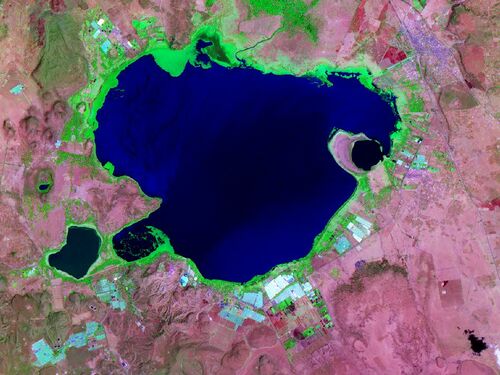Kenya/Gallery: Difference between revisions
< Kenya
Jump to navigation
Jump to search
imported>Anthony.Sebastian mNo edit summary |
imported>Caesar Schinas m (Bot: Update image code) |
||
| (One intermediate revision by one other user not shown) | |||
| Line 1: | Line 1: | ||
{{subpages}} | {{subpages}} | ||
{{Image|Lake Naivasha Kenya.jpg|left|500px|Outside the ground is frozen, quite possibly covered in snow and ice, and yet, stroll through a supermarket in North America or Europe in February, and you'll be confronted with large displays of roses. We expect flowers in winter, and Kenya helps meet those expectations. Straddling the equator, Kenya gets steady sunlight dealt out in days that vary little in length. It's the perfect climate for flowers year-round. The center of Kenya's flower industry is Lake Naivasha, shown here. Bright white squares mix with fields of green, tan and purple along the shores of the lake. Sunlight glints off the long rows of glass greenhouses, turning them silvery blue and white in this view from space. Fallow fields are tan and pink, while growing plants turn the ground bright green. Roses, lilies and carnations are the most common flowers grown in the greenhouses and fields scattered around the lake. The flowers provide an important source of income to Kenya, but the industry comes with a price. Flowers are not held to the same standards for chemical residues as food products. Strong chemical pesticides can be used on the flowers to produce the perfect, pest-free bloom, and this could pose a health risk to workers and local wildlife, including hippos, environmental groups told the Food and Agriculture Organization of the United Nations in 2002. The chemicals may also threatened the water quality of Lake Naivasha, one of Kenya's few freshwater lakes. The Kenya Flower Council instituted a code of conduct establishing guidelines for pesticide that phases out the use of one of the most toxic pesticides. Image Credit: NASA/GSFC/METI/ERSDAC/JAROS, and U.S./Japan ASTER Science Team, Jesse Allen. Caption based on information from Holli Riebeek.}}<br> | |||
<br> | <br> | ||
{{-}} | |||
Latest revision as of 08:25, 8 June 2009

(PD) Photo: NASA
Outside the ground is frozen, quite possibly covered in snow and ice, and yet, stroll through a supermarket in North America or Europe in February, and you'll be confronted with large displays of roses. We expect flowers in winter, and Kenya helps meet those expectations. Straddling the equator, Kenya gets steady sunlight dealt out in days that vary little in length. It's the perfect climate for flowers year-round. The center of Kenya's flower industry is Lake Naivasha, shown here. Bright white squares mix with fields of green, tan and purple along the shores of the lake. Sunlight glints off the long rows of glass greenhouses, turning them silvery blue and white in this view from space. Fallow fields are tan and pink, while growing plants turn the ground bright green. Roses, lilies and carnations are the most common flowers grown in the greenhouses and fields scattered around the lake. The flowers provide an important source of income to Kenya, but the industry comes with a price. Flowers are not held to the same standards for chemical residues as food products. Strong chemical pesticides can be used on the flowers to produce the perfect, pest-free bloom, and this could pose a health risk to workers and local wildlife, including hippos, environmental groups told the Food and Agriculture Organization of the United Nations in 2002. The chemicals may also threatened the water quality of Lake Naivasha, one of Kenya's few freshwater lakes. The Kenya Flower Council instituted a code of conduct establishing guidelines for pesticide that phases out the use of one of the most toxic pesticides. Image Credit: NASA/GSFC/METI/ERSDAC/JAROS, and U.S./Japan ASTER Science Team, Jesse Allen. Caption based on information from Holli Riebeek.
Outside the ground is frozen, quite possibly covered in snow and ice, and yet, stroll through a supermarket in North America or Europe in February, and you'll be confronted with large displays of roses. We expect flowers in winter, and Kenya helps meet those expectations. Straddling the equator, Kenya gets steady sunlight dealt out in days that vary little in length. It's the perfect climate for flowers year-round. The center of Kenya's flower industry is Lake Naivasha, shown here. Bright white squares mix with fields of green, tan and purple along the shores of the lake. Sunlight glints off the long rows of glass greenhouses, turning them silvery blue and white in this view from space. Fallow fields are tan and pink, while growing plants turn the ground bright green. Roses, lilies and carnations are the most common flowers grown in the greenhouses and fields scattered around the lake. The flowers provide an important source of income to Kenya, but the industry comes with a price. Flowers are not held to the same standards for chemical residues as food products. Strong chemical pesticides can be used on the flowers to produce the perfect, pest-free bloom, and this could pose a health risk to workers and local wildlife, including hippos, environmental groups told the Food and Agriculture Organization of the United Nations in 2002. The chemicals may also threatened the water quality of Lake Naivasha, one of Kenya's few freshwater lakes. The Kenya Flower Council instituted a code of conduct establishing guidelines for pesticide that phases out the use of one of the most toxic pesticides. Image Credit: NASA/GSFC/METI/ERSDAC/JAROS, and U.S./Japan ASTER Science Team, Jesse Allen. Caption based on information from Holli Riebeek.